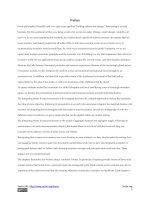Principles of macroeconomics 10e by case fair oster ch13
Bạn đang xem bản rút gọn của tài liệu. Xem và tải ngay bản đầy đủ của tài liệu tại đây (1.02 MB, 40 trang )
PRINCIPLES OF
MACROECONOMICS
PART III The Core of Macroeconomic Theory
TENTH
EDITION
CASE FAIR OSTER
© 2012 Pearson Education, Inc. Publishing as Prentice Hall
Prepared by: Fernando Quijano & Shelly
1 ofTefft
40
PART III The Core of Macroeconomic Theory
© 2012 Pearson Education, Inc. Publishing as Prentice Hall
2 of 40
Aggregate Supply and
the Equilibrium Price
Level
13
CHAPTER OUTLINE
The Aggregate Supply Curve
The Aggregate Supply Curve: A Warning
Aggregate Supply in the Short Run
Shifts of the Short-Run Aggregate Supply Curve
The Equilibrium Price Level
The Long-Run Aggregate Supply Curve
Potential GDP
Monetary and Fiscal Policy Effects
Long-Run Aggregate Supply and Policy Effects
PART III The Core of Macroeconomic Theory
Causes of Inflation
© 2012 Pearson Education, Inc. Publishing as Prentice Hall
Demand-Pull Inflation
Cost-Push, or Supply-Side, Inflation
Expectations and Inflation
Money and Inflation
Sustained Inflation as a Purely Monetary Phenomenon
The Behavior of the Fed
Targeting the Interest Rate
The Fed’s Response to the State of the Economy
Fed Behavior Since 1970
Interest Rates Near Zero
Inflation Targeting
Looking Ahead
3 of 40
The Aggregate Supply Curve
aggregate supply The total supply of
all goods and services in an economy.
The Aggregate Supply Curve: A Warning
PART III The Core of Macroeconomic Theory
aggregate supply (AS) curve A
graph that shows the relationship
between the aggregate quantity of
output supplied by all firms in an
economy and the overall price level.
The aggregate supply curve is not a market supply curve, and it is not
the simple sum of all the individual supply curves in the economy.
Because many firms in the economy set prices as well as output, we
can say an “aggregate supply curve” is really a “price/output response”
curve—a curve that traces out the price decisions and output decisions
of all firms in the economy under a given set of circumstances.
© 2012 Pearson Education, Inc. Publishing as Prentice Hall
4 of 40
The Aggregate Supply Curve
Aggregate Supply
in the Short Run
PART III The Core of Macroeconomic Theory
FIGURE 13.1 The Short-Run
Aggregate Supply Curve
In the short run, the
aggregate supply curve (the
price/output response
curve) has a positive slope.
At low levels of aggregate
output, the curve is fairly
flat.
As the economy approaches
capacity, the curve becomes
nearly vertical.
At capacity, Y*, the curve is
vertical.
© 2012 Pearson Education, Inc. Publishing as Prentice Hall
5 of 40
PART III The Core of Macroeconomic Theory
Which of the following factors affects the shape of the AS curve?
a.
Capacity constraints.
b.
The price of output.
c.
Cost shocks.
d.
Economic growth.
© 2012 Pearson Education, Inc. Publishing as Prentice Hall
6 of 40
PART III The Core of Macroeconomic Theory
Which of the following factors affects the shape of the AS curve?
a.
Capacity constraints.
b.
The price of output.
c.
Cost shocks.
d.
Economic growth.
© 2012 Pearson Education, Inc. Publishing as Prentice Hall
7 of 40
The Aggregate Supply Curve
Aggregate Supply in the Short Run
Why an Upward Slope?
Wages are a large fraction of total costs and wage changes
lag behind price changes. This gives us an upward sloping
short-run AS curve.
PART III The Core of Macroeconomic Theory
Why the Particular Shape?
At some level the overall economy is using all its capital and
all the labor that wants to work at the market wage. At this
level (Y*), the AS curve is vertical.
At low levels of output, the AS curve is flatter. Small price
increases may be associated with relatively large output
responses. We may observe relatively “sticky” wages upward
at this point on the AS curve.
© 2012 Pearson Education, Inc. Publishing as Prentice Hall
8 of 40
The Aggregate Supply Curve
PART III The Core of Macroeconomic Theory
Shifts of the Short-Run
Aggregate Supply Curve
cost shock, or supply shock A
change in costs that shifts the shortrun aggregate supply (AS) curve.
FIGURE 13.2 Shifts of the Short-Run Aggregate Supply Curve
© 2012 Pearson Education, Inc. Publishing as Prentice Hall
9 of 40
The Equilibrium Price Level
equilibrium price level The price level at which the
aggregate demand and aggregate supply curves intersect.
PART III The Core of Macroeconomic Theory
FIGURE 13.3 The Equilibrium Price Level
At each point along the AD curve, both the
money market and the goods market are in
equilibrium.
Each point on the AS curve represents the
price/ output decisions of all the firms in the
economy.
P0 and Y0 correspond to equilibrium in the
goods market and the money market and to a
set of price/output decisions on the part of all
the firms in the economy.
© 2012 Pearson Education, Inc. Publishing as Prentice Hall
10 of 40
PART III The Core of Macroeconomic Theory
Refer to the graph below. At which point is Y = C + I + G?
a.
At Y0, P0 only.
b.
c.
At every point along the AD curve.
At points corresponding to high price levels, such as (Y2, P2).
d.
At points corresponding to low price levels, such as (Y1, P1).
© 2012 Pearson Education, Inc. Publishing as Prentice Hall
11 of 40
PART III The Core of Macroeconomic Theory
Refer to the graph below. At which point is Y = C + I + G?
a.
At Y0, P0 only.
b.
c.
At every point along the AD curve.
At points corresponding to high price levels, such as (Y2, P2).
d.
At points corresponding to low price levels, such as (Y1, P1).
© 2012 Pearson Education, Inc. Publishing as Prentice Hall
12 of 40
The Long-Run Aggregate Supply Curve
FIGURE 13.4 The Long-Run Aggregate Supply
Curve
When the AD curve shifts from AD0 to AD1, the
equilibrium price level initially rises from P0 to
P1 and output rises from Y0 to Y1.
Wages respond in the longer run, shifting the
AS curve from AS0 to AS1.
If wages fully adjust, output will be back at Y0.
PART III The Core of Macroeconomic Theory
Y0 is sometimes called potential GDP.
© 2012 Pearson Education, Inc. Publishing as Prentice Hall
13 of 40
E C O N O M I C S I N PRACTI C E
The Simple “Keynesian” Aggregate Supply Curve
The simple “Keynesian” view of the aggregate
supply curve holds that at any given moment,
the economy has a clearly defined capacity, or
maximum, output.
PART III The Core of Macroeconomic Theory
With planned aggregate expenditure of AE1 and aggregate
demand of AD1, equilibrium output is Y1.
A shift of planned aggregate expenditure to AE2,
corresponding to a shift of the AD curve to AD2, causes
output to rise but the price level to remain at P1.
If planned aggregate expenditure and aggregate demand
exceed YF, however, there is an inflationary gap and the
price level rises to P3.
Despite insights the kinked aggregate supply
curve provides, most economists find it unlikely
that the whole economy suddenly runs into a
capacity “wall” at a specific level of output.
As output expands, some firms and industries will hit capacity before others.
© 2012 Pearson Education, Inc. Publishing as Prentice Hall
14 of 40
The Long-Run Aggregate Supply Curve
Potential GDP
potential output, or potential GDP The level of aggregate
output that can be sustained in the long run without inflation.
PART III The Core of Macroeconomic Theory
Short-Run Equilibrium Below Potential Output
Although different economists have different opinions on how
to determine whether an economy is operating at or above
potential output, there is general agreement that there is a
maximum level of output (below the vertical portion of the
short-run aggregate supply curve) that can be sustained
without inflation.
© 2012 Pearson Education, Inc. Publishing as Prentice Hall
15 of 40
Monetary and Fiscal Policy Effects
FIGURE 13.5 A Shift of the Aggregate Demand
Curve When the Economy Is on the Nearly Flat
Part of the AS Curve
PART III The Core of Macroeconomic Theory
Aggregate demand can shift to the right for a
number of reasons, including an increase in
the money supply, a tax cut, or an increase in
government spending.
If the shift occurs when the economy is on
the nearly flat portion of the AS curve, the
result will be an increase in output with little
increase in the price level from point A to
point A′ .
© 2012 Pearson Education, Inc. Publishing as Prentice Hall
16 of 40
PART III The Core of Macroeconomic Theory
Monetary and Fiscal Policy Effects
FIGURE 13.6 A Shift of the Aggregate Demand Curve When the Economy Is Operating At or Near
Maximum Capacity
If a shift of aggregate demand occurs while the economy is operating near full capacity, the
result will be an increase in the price level with little increase in output from point B to point
B′ .
© 2012 Pearson Education, Inc. Publishing as Prentice Hall
17 of 40
PART III The Core of Macroeconomic Theory
When the economy is producing at full capacity, the aggregate
supply curve becomes:
a.
Vertical.
b.
Horizontal.
c.
Upward sloping.
d.
Downward sloping.
© 2012 Pearson Education, Inc. Publishing as Prentice Hall
18 of 40
PART III The Core of Macroeconomic Theory
When the economy is producing at full capacity, the aggregate
supply curve becomes:
a.
Vertical.
b.
Horizontal.
c.
Upward sloping.
d.
Downward sloping.
© 2012 Pearson Education, Inc. Publishing as Prentice Hall
19 of 40
Monetary and Fiscal Policy Effects
Long-Run Aggregate Supply and Policy Effects
It is important to realize that if the AS curve is vertical in the long run,
neither monetary policy nor fiscal policy has any effect on aggregate
output in the long run.
PART III The Core of Macroeconomic Theory
The longer the lag time between wages and output prices, the greater
the potential impact of monetary and fiscal policy on aggregate output.
Some argue that wages do not fall during slack periods and that the
economy can get “stuck” at an equilibrium below potential output. In
this case, monetary and fiscal policy would be necessary to restore full
employment.
© 2012 Pearson Education, Inc. Publishing as Prentice Hall
20 of 40
Causes of Inflation
Demand-Pull Inflation
demand-pull inflation Inflation that is
initiated by an increase in aggregate demand.
PART III The Core of Macroeconomic Theory
If the economy is operating on the steep portion of the AS curve at the
time of the increase in aggregate demand, most of the effect will be an
increase in the price level instead of an increase in output.
If the economy is operating on the flat portion of the AS curve, most of
the effect will be an increase in output instead of an increase in the
price level.
© 2012 Pearson Education, Inc. Publishing as Prentice Hall
21 of 40
Causes of Inflation
Cost-Push, or Supply-Side, Inflation
cost-push, or supply-side, inflation Inflation caused by an increase in costs.
FIGURE 13.7 Cost-Push, or Supply-Side,
Inflation
PART III The Core of Macroeconomic Theory
An increase in costs shifts the AS curve to
the left.
By assuming the government does not
react to this shift, the AD curve does not
shift, the price level rises, and output falls.
stagflation Occurs when output is falling at the same time that prices are rising.
© 2012 Pearson Education, Inc. Publishing as Prentice Hall
22 of 40
Causes of Inflation
Cost-Push, or Supply-Side, Inflation
FIGURE 13.8 Cost Shocks Are Bad
News for Policy Makers
PART III The Core of Macroeconomic Theory
A cost shock with no change in
monetary or fiscal policy would
shift the aggregate supply curve
from AS0 to AS1, lower output from
Y0 to Y1, and raise the price level
from P0 to P1.
Monetary or fiscal policy could be
changed enough to have the AD
curve shift from AD0 to AD1.
This policy would raise aggregate
output Y again, but it would raise
the price level further, to P2.
© 2012 Pearson Education, Inc. Publishing as Prentice Hall
23 of 40
Causes of Inflation
Expectations and Inflation
When firms are making their price/output decisions, their expectations
of future prices may affect their current decisions. If a firm expects that
its competitors will raise their prices, it may raise its own price.
PART III The Core of Macroeconomic Theory
The firm’s profit-maximizing optimum price is presumably not too far
from the average of its competitors’ prices.
Expectations can lead to an inertia that makes it difficult to stop an
inflationary spiral. If prices have been rising and if people’s
expectations are adaptive, firms may continue raising prices even if
demand is slowing or contracting.
Given the importance of expectations in inflation, central banks aim to
keep them low.
© 2012 Pearson Education, Inc. Publishing as Prentice Hall
24 of 40
E C O N O M I C S I N PRACTI C E
Inflationary Expectations in China
Expectations that prices
will rise can be selffulfilling as firms raise
prices in expectation that
all other prices will rise.
PART III The Core of Macroeconomic Theory
This same phenomenon
is discussed in the
context of China.
It is also interesting to
note that many people
believed the official
statistics on inflation
understated their own experience.
Inflation Perceptions Run High in China
The Wall Street Journal
© 2012 Pearson Education, Inc. Publishing as Prentice Hall
25 of 40









